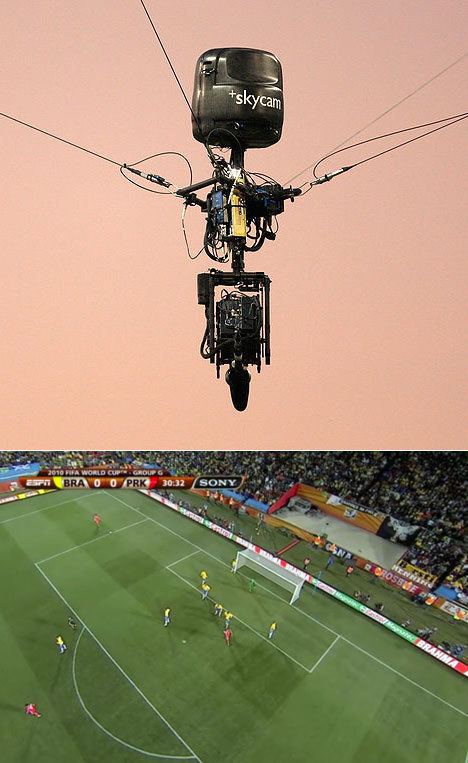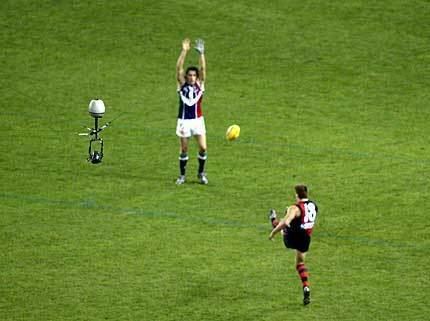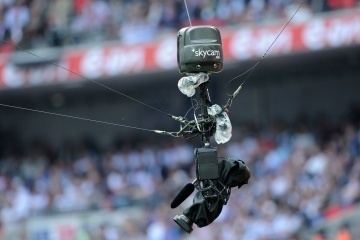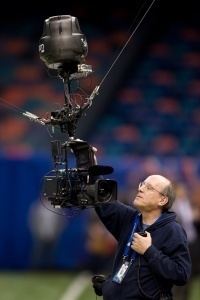
Skycam can get down close to the action on the field.
It swoops and dives like an enormous flying arachnid from your worst nightmares. But its not a black widow that grew up too close to a nuclear power plant. Instead, its a rather ominous (and still spider-like) camera contraption dangling in the air, chasing football players as they run for their lives (or a touchdown).
Its Skycam, the original flying camera, and youve probably seen plenty of footage created by this radical-looking gizmo. Skycam is a wire-flown, remote-controlled camera, and its been zooming around stadiums and other venues for years now, providing fantastic camera views that would otherwise be nearly impossible to achieve.
With Skycam, people who watch American football on television have a birds eye view just above and behind the quarterback. Compared to old sideline views, Skycam is almost like being in the huddle.
How Does Skycam Work? #Video
Not sure if you know exactly what Skycam is? If youve ever watched a major sporting event on television, such as NFL Sunday Night Football, you may have intermittently caught a glimpse of an airborne device gracefully floating above the field, hanging from multiple ropes. Thats the Skycam system.
Skycam offers a video-game-type view that leans heavily on modern technologies. Without fast computers and user-friendly software, as well as some really strong guide ropes, the whole setup would be unfeasible.
But thanks to smart engineering, Skycam is now nearly a staple of broadcasting for special events. Keep reading and youll see how video cameras grew wiry wings and took to the air.
From Steadi to Sky

Before you walk, you crawl. Before Skycam, there was Steadicam. Both emerged from the brain of camera operator, inventor and entrepreneur Garrett Brown. In the early 1970s, Brown realized that there had to be a better way to shoot video from a moving camera, without a traditional, time-consuming dolly and rails.
He came up with Steadicam, a vest equipped with counterbalanced equipment that virtually eliminated hand shake and vibrations as a camera person walked to follow the action of a scene. By the middle of the decade, Steadicam had exploded in popularity in Hollywood, and was used on iconic films such as "Rocky."
The success of Steadicam gave Brown momentum to try something even more audacious – filming athletic action from the sky. Helicopters wouldnt work for all sorts of reasons, such as the unsavory potential for accidentally decapitating spectators. So he set about planning and engineering a device that could swoop through open spaces, offering a birds eye view of the action below.

He envisioned a camera suspended from ropes or cables, zooming around and recording angles never before possible. It didnt take him long to realize his dream.
In 1984, Skycam made one of its first real trial runs during a preseason NFL game between the San Francisco 49ers and the San Diego Chargers. It went well enough that in 1985, NBC licensed Skycam for its coverage of the Orange Bowl matchup between the Washington Huskies and Oklahoma Sooners.
Audiences loved the sky-high views and dynamic angles. ABC licensed Skycam to record the famous Live Aid concerts in 1985, wowing crowds with its audio-video magic.
And then, suddenly, Skycam found itself mostly grounded. It was expensive to operate and pricey to license, and Brown couldnt justify the ongoing expenses.
How Skycam Soars

The Skycam rig is suspended over the action with reels of Kevlar-reinforced rope.
The Skycam system has been used in more than 100 different arenas around the globe. It takes several people about two days to ready Skycam for a broadcast. As they work, they prepare the core pieces that make Skycam fly.
For starters, there must be four high points surrounding the action. In the case of football, these are often lighting towers on the periphery of the stadium. For non-football events, organizers must utilize other elevated points or even erect temporary platforms.
Below each of these four points are large reels loaded with coils of Kevlar-reinforced rope 0.1-inched (2.5-millimeters) in diameter. Each reel has an onboard computer controlling motors that precisely reel the thousands of feet rope in or out as needed.
These ropes spool from the reels to pulleys in the towers and then meet in a center point above the field. In the center, of course, is the suspended Skycam unit, bundled with other components in whats called the spar.
The spar weighs roughly 50 pounds (22.7 kilograms) and includes a 1080i HD video camera paired with a Fujinon ZA12x4.5mm wide-angle lens, sensors for stabilization, a microphone and motors that pan and tilt the camera. The camera can pan a full 360 degrees and tilt 180 degrees for a maximum view of the action.
The spar is integrated with gyroscopic stabilizers that prevent wobbly or shaky video. So instead of a gut-churning home video look, viewers see smooth, crisp video that looks colorful and sharp on their television screens.
Video signals travel along the suspension ropes, which are coupled with optical fiber line for fast data transmission. Using this hardwired approach instead of wireless transmission means greater reliability in varied settings.
All of this connects to a central control computer. In real time, the computer controls and monitors dozens of parameters. It also accepts inputs from the pilot, who controls the cameras flight path, as well as the camera operator, who focuses, pans, tilts and otherwise makes sure that the camera is following the action and not broadcasting random shots of passing clouds.
Skycam on the Horizon

A technician inspects a Skycam before an event.
Some fans and even team owners may cringe as Skycam hurtles at 30 miles (48.3 kilometers) per hour past their favorite (and highly compensated) athletes. After all, a heavy camera doing its best impression of meteorite could leave a permanent crater in the back of someones noggin.
Skycams operators always tout the systems redundant safety features. It all starts with the software.
Critically, the software automatically performs obstacle avoidance duties. Before a broadcast, the computer operator presets boundaries for the camera and uses the software to designate no-fly zones, such as the scoreboard and video screen suspended in the middle of a basketball arena. Doing this work in advance leaves the pilot free to follow action on the field below without having to worry about causing a spectacular collision and equally spectacular public relations fiasco.
These precautions cant prevent every incident, though. During a 2007 NFL game between the Seattle Seahawks and New Orleans Saints, the camera pilot accidentally guided the camera onto the field. The game was stopped momentarily.
At the 2011 Insight Bowl between the Iowa Hawkeyes and Oklahoma Sooners, a fastener on the Skycam assembly came apart, causing the camera to crash onto the field below. The unit narrowly missed Iowa quarterback Marvin McNutt.
During the 2013 Coca Cola 600 at Charlotte Motor Speedway, a suspension rope snapped and fell into the fans in the grandstand. As if that wasnt bad enough, the rope also landed on the track, where stock cars snagged it, causing it to whip through frantic spectators. Ten people were hurt, three cars were damaged and the race was delayed. Fortunately for everyone involved, no one was seriously injured.
These kinds of accidents have been rare. Mostly, audiences have been dazzled by the constant improvement and dynamic coverage that Skycam provides.
Skycam and its cousins broke all sorts of new ground in TV broadcasts. They bring flying, Superman-like angles possible for sports, concerts and movies and make these experiences more powerful than ever before.
Yet even as Skycam coverage becomes more common, it may face serious competition from drones. Drones can carry increasingly heavy payloads and they dont require a system of ropes and reels to remain airborne.
So in a few years, you may see swarms of drones hovering over your favorite team. But until then, Skycam coverage offers views and angles that no other camera system can match.
.jpg)